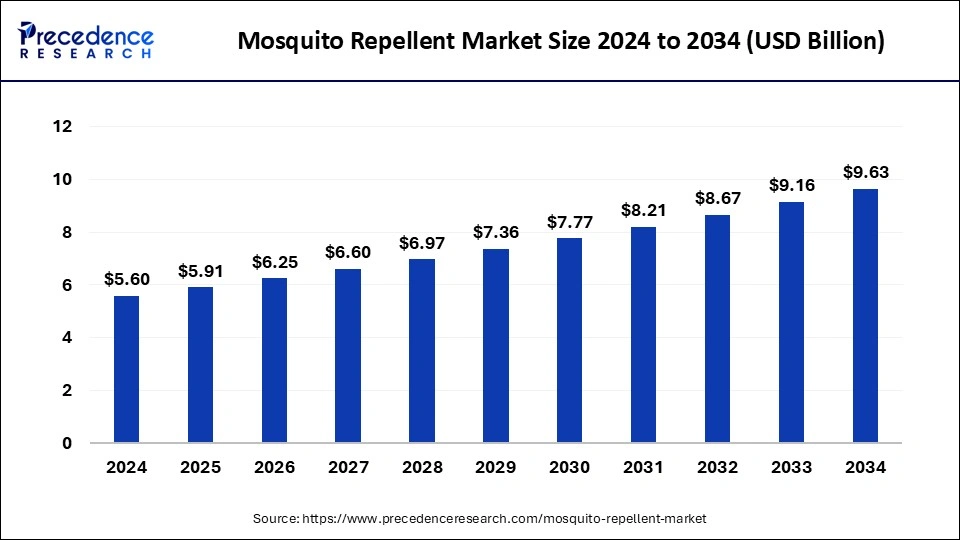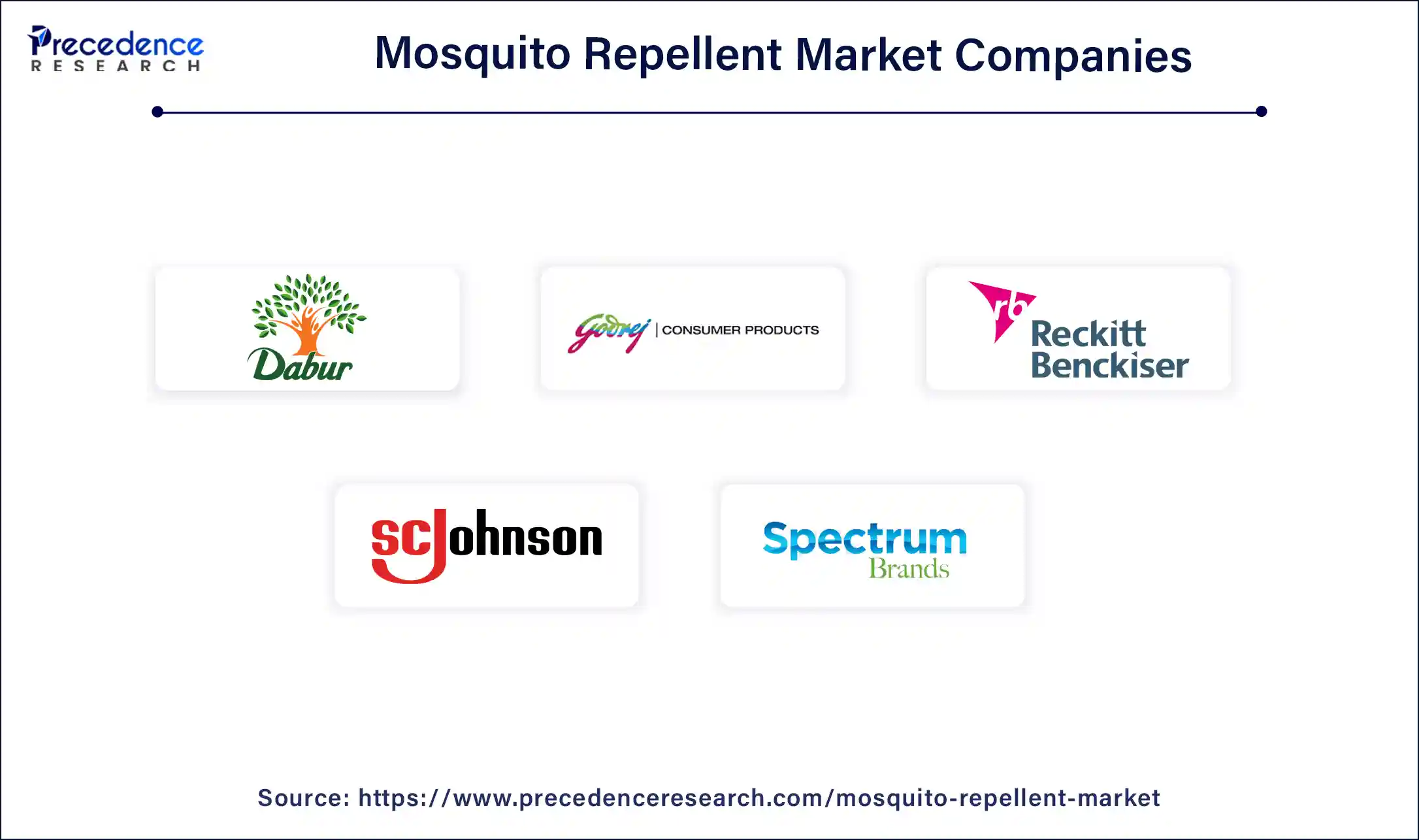The global mosquito repellent market size is calculated at USD 5.91 billion in 2025 and is forecasted to reach around USD 9.63 billion by 2034, accelerating at a CAGR of 5.57% from 2025 to 2034. The market sizing and forecasts are revenue-based (USD Million/Billion), with 2024 as the base year.
The global mosquito repellent market size was estimated at USD 5.60 billion in 2024 and is predicted to increase from USD 5.91 billion in 2025 to approximately USD 9.63 billion by 2034, expanding at a CAGR of 5.57% from 2025 to 2034. The mosquito repellent market is in high demand due to growing awareness of diseases like chikungunya, dengue, malaria, and the Zika virus.

Growing health concerns, more knowledge of mosquito-borne diseases, and a growing need for mosquito control solutions have all contributed to the market's notable expansion in recent years for repellents. There is a greater need for mosquito repellents due to the rise in diseases like dengue, chikungunya, malaria, and the Zika virus. The mosquito repellent market is growing as a result of growing consumer knowledge of the health concerns connected with mosquito bites. The creation of novel and potent formulas, such as organic and herbal repellents, draws in customers who are concerned about their health.
The mosquito repellent market is expected to increase steadily due to rising demand in different regions, innovation, and health concerns. To increase their market share, businesses are concentrating on creating safer, more efficient, and ecologically friendly products. Success in this dynamic industry will need a combination of effective marketing and distribution initiatives, as well as ongoing investment in research and development.
Mosquitoes multiply due to higher population density and urbanization, which makes repellents necessary. The mosquito repellent market is growing as a result of a big population base and a high prevalence of diseases spread by mosquitoes. Growing inclination for goods containing natural components like neem, citronella, and eucalyptus oil. Developments in wearable technology, including patches and wristbands.
| Report Coverage | Details |
| Market Size by 2034 | USD 9.63 Billion |
| Market Size in 2025 | USD 5.91 Billion |
| Growth Rate from 2025 to 2034 | CAGR of 5.57% |
| Largest Market | Asia Pacific |
| Base Year | 2024 |
| Forecast Period | 2025 to 2034 |
| Segments Covered | Product Type, Distribution Channel, and Regions |
| Regions Covered | North America, Europe, Asia-Pacific, Latin America, and Middle East & Africa |
Consumer preference for natural products
The possible health hazards linked to the synthetic chemicals frequently present in conventional mosquito repellents, such as DEET, are becoming more well-known to consumers. A rising number of consumers are choosing goods free of harmful substances. Many people believe that natural mosquito repellents are better for the environment. Products from the mosquito repellent market that are biodegradable and free of dangerous chemicals that can harm ecosystems are preferred by customers who are concerned about their environmental impact. Natural repellent compositions are now more effective than synthetic ones, thanks to advancements in science. Certain ingredients are known to repel; these include eucalyptus, lemongrass, citronella, and peppermint oils.
Effectiveness issues
Over time, mosquitoes may become resistant to some of the active components included in repellents, hindering the growth of the mosquito repellent market. Because of this resistance, the repellents may stop working to keep mosquitoes away. Certain portions of the skin may remain exposed to mosquito bites even after using insect repellent. There may be regional variations in the effectiveness of repellents due to the fact that different mosquito species may react differently to different chemicals. In order to address effectiveness concerns, ongoing research and development are needed to refine formulations, increase efficacy against populations of mosquitoes that have developed resistance, and inform customers about the proper usage and selection of repellent products. Regulatory bodies are also essential in guaranteeing that repellents that are sold adhere to safety and effectiveness requirements.
Innovative delivery systems
Spatial repellents create a mosquito-free zone by dispersing active components into the air as an alternative to applying repellents directly to the skin. This technique is used in gadgets like mosquito coils and plug-in diffusers. They can effectively cover greater areas and are appropriate for indoor use. By strengthening the repellents' durability or facilitating better skin penetration, nanoparticles can boost their effectiveness. Longer-lasting mosquito protection can be achieved by the creation of innovative formulations with controlled release qualities made possible by nanotechnology. The focus of innovations in this field is the use of natural substances and eco-friendly delivery methods that minimize harm to ecosystems while effectively repelling mosquitoes. This creates opportunities for players in the mosquito repellent market.
The spray segment dominated the mosquito repellent market in 2024. Consumer need for simple, practical solutions to prevent mosquito-borne illnesses has led to a sizable and expanding spray segment in the mosquito repellent industry. The market for repellents, in general, includes a sizeable portion of the spray category. Growing public knowledge of mosquito-borne illnesses such as malaria, dengue, Zika virus, and West Nile virus has led to steady market expansion. Increased prevalence of illnesses like dengue, malaria, and the Zika virus has increased the need for efficient insect repellents. Some customers may be put off by the possibility of adverse reactions and skin side effects from chemical-based repellents like DEET.
The vaporizer segment is expected to grow rapidly in the mosquito repellent market during the forecast period. In order to produce an environment that is unfriendly to mosquitoes, machines that heat a liquid solution containing chemicals that repel insects are used in the vaporizer segment of the mosquito repellent industry. These vaporizers are usually connected to electrical outlets and, depending on the device, are meant to offer continuous protection for a number of hours or even days. For their convenience, vaporizers are recommended. Their low setup and maintenance requirements make them a desirable choice for households with hectic schedules. Vaporizers have a major benefit over other repellents like sprays and coils in that they offer continuous protection as long as they are plugged in.
The independent stores segment held the largest share of the mosquito repellent market in 2024. Small, privately held retail establishments that offer repellent goods are referred to as independent stores in the mosquito repellent sector. These shops usually cater to small communities and are run independently of big-box retailers or franchises.
A wide variety of mosquito repellent items, such as sprays, lotions, coils, and natural/organic alternatives, are frequently available at independent retailers. These shops usually maintain a tight relationship with their clients, providing advice and individualized care. The market for efficient insect repellents is driven by consumers' growing health consciousness and awareness of diseases spread by mosquitoes. Large retail chains, internet merchants, and supermarkets that might provide a greater selection of goods at competitive prices compete with independent retailers.
The online sales channel segment is expected to grow rapidly in the mosquito repellent market in the upcoming years. Online shopping has become more convenient for customers due to the increase in smartphone usage and internet penetration. In developing nations where e-commerce is expanding quickly, this tendency is especially prominent. Customers can acquire mosquito repellent items conveniently from the comfort of their homes when they shop online. For people who live in isolated places with little access to actual stores, this is really helpful.
Customers who are concerned about costs are drawn to e-commerce platforms by their regular discounts, promotions, and package offers. For many consumers, this makes online buying a more economical choice. Customers can see other buyers' feedback and ratings on online platforms. This data boosts consumer confidence in the quality of the products and aids in making well-informed purchasing decisions.
Asia Pacific held the largest share of the mosquito repellent market in 2024. The increasing prevalence of mosquito-borne diseases and growing awareness of preventive measures are two major reasons driving the robust growth of the mosquito repellent market in the region. Government and non-government programs to lower mosquito-borne illnesses, improvements in product formulations, and the launch of natural and skin-friendly repellents are major factors contributing to this growth. In Delhi, for instance, efforts to prevent illnesses like dengue and chikungunya have increased the use of insect repellents. The market for mosquito repellent in Asia Pacific is expected to grow significantly due to factors such as increased health consciousness, creative product offers, and encouraging government policies.
North America is expected to host the fastest-growing mosquito repellent market during the forecast period. Product formulations are divided into three categories: chemical-based, natural and organic, and hybrid. Because consumers prefer eco-friendly products, there is an increasing need for natural and organic repellents. The need for insect repellents is rising due to an increase in incidences of diseases like dengue fever, malaria, and the Zika virus. There is a growing need for natural and herbal repellents due to health concerns about chemical-based repellents. With steady growth anticipated, the insect repellent market in North America appears to have a bright future. The market will be driven by a number of important reasons, including growing distribution networks, continuing product advancements, and rising customer awareness.

By Product Type
By Distribution Channel
By Geography
For inquiries regarding discounts, bulk purchases, or customization requests, please contact us at sales@precedenceresearch.com
No cookie-cutter, only authentic analysis – take the 1st step to become a Precedence Research client